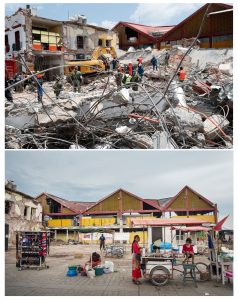
By Isabel Reviejo
Union Hidalgo, Mexico, Sep 7 (EFE).- Finding one’s way around Union Hidalgo was complicated after the earthquake on Sept. 7, 2017, which crumbled hundreds of facades and collapsed buildings down to their foundations. One year later, as in other municipalities of southern Mexico, the challenge remains the same: reconstruction.
Some 10 minutes before midnight, a powerful magnitude-8.2 earthquake shook the state of Chiapas and spread its wreckage through the southern and central parts of the country, causing massive devastation that left, besides serious damage to homes and heritage, 98 people dead.
Twelve months later, rubble and scaffolding continue to clutter the streets of towns on the Isthmus of Tehuantepec, the chief scene of the tragedy.
In the eastern Oaxacan town of Union Hidalgo, a construction worker was repairing the wall of Erasmo Lopez’s home, where walking through the different rooms required dodging around ladders and sacks of cement.
“Now we’re starting to see a little life. There are homes starting to be reconstructed, houses that are halfway rebuilt and it won’t be long before some are finished. The town is making a comeback,” he told EFE, adding that after the temblor, local residents could easily get lost when they went wandering through the rubble to “visit their friends.”
In Oaxaca and Chiapas, two of the country’s poorest states, the quakes on Sept. 7 and 19 of last year left 121,701 homes damaged, according to official figures.
The houses can’t be rebuilt “in the traditional way, as has been done in the past,” but in such a way that the structures are reinforced and “can withstand any future temblor,” Erasmo said.
In the same street, the home of Macario Ruiz is still braced with planks of wood. Getting started with the reconstruction of this century-old house wasn’t easy.
“It took us awhile to clean up the place, and there was a time when there were no construction workers or contractors available. So we had to wait awhile,” he said.
After Sept. 7, the Mexican government distributed among those left homeless debit cards worth the money needed to buy construction materials. This aid, those affected all agree, wasn’t enough for people who suffered severe damages or the total loss of their property.
Some displaced persons have received the support of Fideicomiso Fuerza Mexico, organized by the private sector to unite donations that have been distributed among various reconstruction projects.
The home of Blanca Estela Cornelio is one that was reconstructed through this initiative. The colors of her home, a still impeccable cream with red accents, show that it is newly painted.
And a small wooden slab on one side of the patio says “For God, nothing is impossible.”
